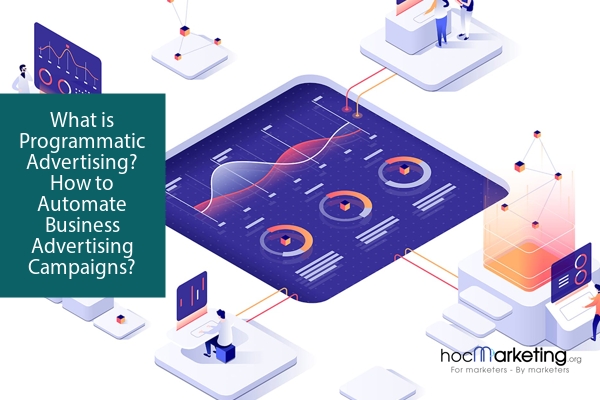
What is Programmatic Advertising? How to Automate Business Advertising Campaigns?

Learn how Programmatic Advertising can benefit your business by automating advertising campaigns. Follow these 5 steps to set up your campaign, define goals and budget, choose an advertising platform, set targeting parameters, and optimize performance.
Programmatic advertising has been making waves in the advertising industry in recent years. With the rise of digital marketing, businesses are looking for ways to automate their advertising campaigns to reach their target audience more efficiently. But what exactly is programmatic advertising? In this blog post, we will delve into the definition of programmatic advertising, its benefits, and how to automate your business advertising campaigns using this approach. By the end of this post, you will have a clear understanding of programmatic advertising and how it can help you streamline your advertising efforts.
What is Programmatic Advertising?
Programmatic advertising is an automated way of buying and selling digital advertisements. It uses algorithms and machine learning to target specific audiences and serve relevant ads in real-time. This technology allows advertisers to reach their target audience more efficiently and at a lower cost, while providing publishers with a way to monetize their inventory. With programmatic advertising, the entire process is streamlined, from ad placement to optimization, allowing advertisers to focus on their core business goals. In the following sections, we will explore the benefits of programmatic advertising and how to automate business advertising campaigns with this technology.
Benefits of Programmatic Advertising
Programmatic advertising offers numerous benefits to businesses of all sizes. Firstly, it allows for a more efficient and streamlined advertising process, freeing up time and resources for other important business areas. Additionally, programmatic advertising enables highly targeted and personalized campaigns, increasing the likelihood of reaching the most relevant audience and generating better results. By automating the advertising process, programmatic advertising also reduces the risk of human error and ensures campaigns are executed accurately and consistently. Furthermore, programmatic advertising enables real-time optimization and data-driven decision making, allowing businesses to adapt their campaigns quickly and effectively based on performance insights. Overall, programmatic advertising offers businesses a more effective and efficient advertising solution that can help maximize ROI and achieve business goals.
How to Automate Business Advertising Campaigns with Programmatic Advertising?
Programmatic advertising is an automated process of buying and selling online advertising space. It uses data and algorithms to determine which ad to show to which user, at what time, and at what price. This highly efficient and effective advertising method has become increasingly popular among businesses of all sizes. In this section, we will discuss the steps to automate business advertising campaigns with programmatic advertising.
The first step in automating an advertising campaign is to define the advertising goals and budget. The goals should be specific, measurable, achievable, relevant, and time-bound (SMART). The budget should be realistic and based on the goals. Once the goals and budget are established, the next step is to choose a programmatic advertising platform. There are many platforms available, and businesses should choose the one that best suits their needs.
The third step is to create the advertising campaign. This involves designing the ad creatives and writing the ad copy. The ad creatives should be eye-catching and relevant to the target audience. The ad copy should be concise and persuasive. The fourth step is to set targeting parameters. This involves selecting the audience for the ad and specifying the criteria for targeting. The targeting parameters should be based on factors such as demographics, interests, and behavior.
The final step is to optimize the campaign performance. This involves monitoring the campaign and making adjustments based on the results. The programmatic advertising platform provides real-time data on the ad performance, and businesses can use this data to improve the campaign. Optimization can involve adjusting the targeting parameters, changing the ad creatives or copy, or adjusting the bidding strategy.
In summary, automating business advertising campaigns with programmatic advertising involves defining the goals and budget, choosing a platform, creating the campaign, setting targeting parameters, and optimizing the campaign performance. By following these steps, businesses can create highly effective and efficient advertising campaigns that reach the right audience at the right time and at the right price.
Step 1: Define Advertising Goals and Budget
Defining advertising goals and budget is the first step to take when it comes to automating business advertising campaigns with programmatic advertising. This step is crucial as it sets the foundation for the entire campaign. The goals should be specific, measurable, achievable, relevant, and time-based. In other words, they should be SMART goals. The budget should also be realistic and aligned with the goals set. It is important to have a clear understanding of what the business wants to achieve and how much they are willing to spend to achieve it. Once the goals and budget are defined, the next step is to choose a programmatic advertising platform.
Step 2: Choose Programmatic Advertising Platform
Choosing the right programmatic advertising platform is a critical step towards automating your business advertising campaigns. With so many platforms available in the market, it can be overwhelming to choose the best one for your business needs. Before making a decision, you need to consider a variety of factors, such as the platform's features, pricing, user interface, and customer support.
One of the most important factors to consider is the platform's targeting capabilities. A good programmatic advertising platform should provide advanced targeting options that allow you to reach your target audience effectively. For instance, you may want to use a platform that offers geo-targeting, device targeting, or behavioral targeting options.
Another crucial factor to consider is the platform's integration capabilities. Ideally, you should choose a platform that integrates seamlessly with your existing advertising tools, such as your ad server or analytics software. This will help you to streamline your advertising workflows and improve your campaign performance.
Additionally, you should look for a platform that provides real-time reporting and analytics. This will enable you to monitor your campaign performance and make data-driven decisions to optimize your campaigns. Some platforms even offer AI-powered optimization that uses machine learning algorithms to automatically optimize your campaigns for better results.
Finally, you should consider the platform's pricing model. Some platforms charge a flat fee, while others charge based on the number of impressions or clicks. It's important to choose a platform that aligns with your budget and advertising goals.
Overall, choosing the right programmatic advertising platform is crucial for automating your business advertising campaigns. By considering the factors mentioned above, you can make an informed decision and choose a platform that meets your business needs.
Step 3: Create Advertising Campaign
Creating an advertising campaign is a crucial step in programmatic advertising. This is where you design the ads that will be displayed on various platforms, including websites, social media, and mobile apps. The success of your campaign depends on how well you create your ads, so it is important to pay attention to the details and ensure that they are engaging and relevant to your target audience.
To begin, you need to decide on the type of ad format you want to use, such as display ads, video ads, or native ads. Each format has its own advantages and disadvantages, so it is important to choose the one that best suits your business goals and target audience. Once you have chosen a format, you can start creating the actual ads.
The content of your ads should be visually appealing and attention-grabbing. This can be achieved through the use of high-quality images, animation, and interactive elements. Remember to keep your messaging clear and concise, and to highlight the unique selling points of your product or service.
In addition to the visual elements, you also need to write compelling ad copy. This is the text that appears alongside your ad, and it should be persuasive and informative. Use attention-grabbing headlines and clear calls-to-action to encourage viewers to click on your ad and learn more about your business.
Once you have created your ads, it is important to test them to ensure that they are effective. This can be done through A/B testing, where you create two versions of the same ad and see which one performs better. You can also use data analytics to track the performance of your ads and make adjustments as needed.
Creating an effective advertising campaign requires careful planning and attention to detail. By following these steps, you can create ads that are engaging, relevant, and effective in reaching your target audience.
Step 4: Set Targeting Parameters
To ensure that your programmatic advertising campaign reaches the right audience, it is crucial to set targeting parameters. These parameters help you narrow down your audience based on factors such as demographics, interests, behavior, and location. By doing so, you can ensure that your ads are seen by the right people, at the right time, and on the right platforms. In this section, we will discuss the importance of setting targeting parameters and the different types of targeting options available in programmatic advertising.
Step 5: Optimize Campaign Performance
Once your programmatic advertising campaign is up and running, it’s important to continually optimize it to ensure that you’re achieving your advertising goals and getting the most out of your budget. The following are some tips to help you optimize your campaign performance:
Firstly, regularly review your campaign data and analytics to identify areas for improvement. Look at metrics such as click-through rates, conversion rates, and cost per acquisition, and use this information to make data-driven decisions about how to improve your campaign.
Secondly, adjust your targeting parameters as needed to ensure that you’re reaching the right audience. This might involve adding or removing certain targeting options, such as geographic location, demographic information, or interests.
Thirdly, experiment with different ad formats and messaging to see what resonates best with your target audience. This could involve testing different ad copy, images, or calls to action, and measuring the impact on campaign performance.
Finally, consider using advanced optimization techniques such as machine learning or predictive analytics to help you identify patterns and trends in your data, and make recommendations for how to improve your campaign. By continually optimizing your programmatic advertising campaign, you can ensure that you’re getting the best possible results and ROI for your advertising spend.
Summary
In conclusion, programmatic advertising has revolutionized the way businesses advertise their products or services. By automating the process, it allows for more efficient targeting, real-time optimization, and a higher return on investment. However, it is important to understand the complexities of programmatic advertising and work with experts to ensure successful campaigns. With the right strategy and execution, programmatic advertising can lead to significant growth and success for businesses of all sizes.









